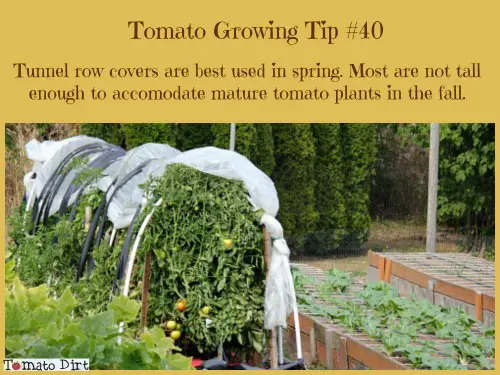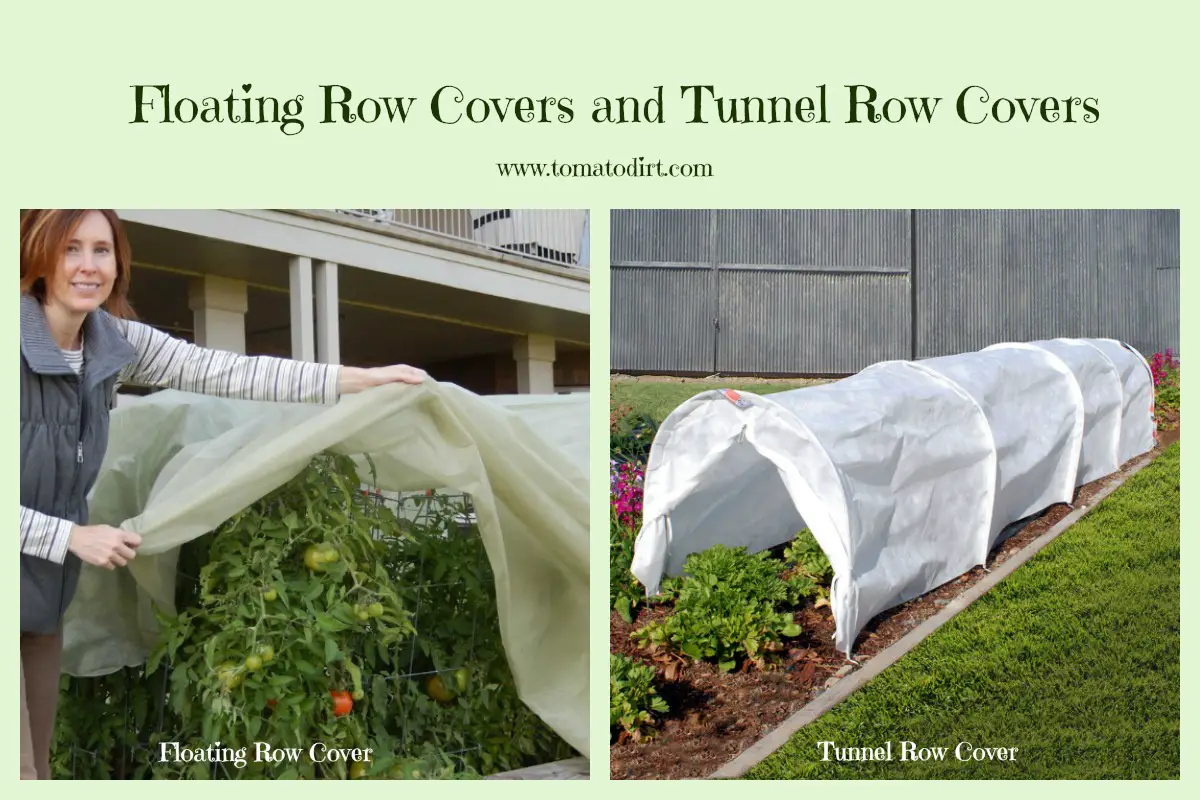FREE: 10 Must-Know Tomato Growing Tips Get The Guide
Read our affiliate disclosure here.
Floating Row Covers and Tunnel Row Covers for Protecting Tomatoes
Since 2010, Tomato Dirt has garnered 4.8+ million views, making it the web’s leading online source for growing tomatoes in the home garden. Award-winning writer and Tomato Dirt owner Kathy Widenhouse has helped thousands of home gardeners grow healthier tomatoes. Be one of them when you get Tomato Dirt’s Growing Guide here.
As you consider protecting plants from frost, take a look at floating row covers and tunnel row covers.
Both kinds of row covers work in the same way. The garden soil is warmed during the day by the sun as it penetrates row covers. At night, the captured heat in the soil helps protect plants from frost. Row covers also provide an extra layer of protection as cold temperatures and frost fall on your garden.
Floating Row Covers
Floating row covers are sheets of lightweight fabrics that are draped directly over tomato plants. Because you adjust the height when you set them out they are suitable for both spring tomato seedlings (which are short) as well as mature tomato plants (which can be quite tall).
Floating Row Cover Tips
- Most row covers are made from light-colored, non-woven, breathable fabric, which allows them to transmit light. That means they need not be removed during the day but can remain on plants for an extended time.
- Drawstrings and cord locks help fit row covers onto plants and hold them in place.
- Row covers are reusable from season to season.
- They can provide up to 8 degrees of frost protection.
Tunnel Row Covers
Tunnel row covers (also called framed row covers or tunnels) cover an entire row of tomato plants or seedlings.
Tunnel Row Cover Tips
- Most tunnel row covers are not tall enough to accommodate mature fall tomatoes. They are best used in the spring to protect tomato plants from late frost. Tunnels protect plants from wind as well as frost and cold temperatures.
- You can purchase pre-made tunnel row covers or make your own.
- Tunnels are made of wire or fiberglass hoops covered with nonwoven fabric or plastic.
- Light-colored or clear material allows light to penetrate tunnels. Tunnels can remain on rows for an extended period of time, allowing interior air to warm.
- Tunnels can be ventilated to prevent overheating during the day. Poke holes in plastic covering to prevent overheating inside. (Breathable fabrics are less likely to overheat the tunnel interior.)
- Christmas lights or a spotlight inside tunnels can provide extra warmth.
- Remove tunnels when the danger of frost has passed.
How to Make Your Own Tunnel Covers
- Buy inexpensive wire or fiberglass hoops to make your own tunnel row covers.
- Set hoops three to five feet apart along the tomato row or raised bed.
- Drape lightweight netting, row cover fabric, or plastic lengthwise along hoops.
- Bury edges of fabric or plastic into the soil. When using coverings on raised beds, simple staple covering edges to its sides.
- Poke holes in plastic covering to prevent overheating inside. (Breathable fabrics are less likely to overheat tunnel interior.)
- String Christmas lights or a spotlight inside tunnels for extra warmth.
- Remove tunnels when the danger of frost has passed.
More on Protecting Plants From Frost
Protecting plants from frost: FAQs ...
Protecting tomatoes from frost and freezing: the basics ...
13 Easy Ways to Protect Plants from Frost ...
How to protect tomatoes on cold nights ...
Different types of frost protection for tomato plants ...
How to use individual frost covers to protect tomatoes ...
More tips for protecting tomatoes on our Pinterest board ...
Return from Floating Row Covers and Tunnel Row Covers to Tomato Dirt home
As an Amazon Associate and Rakuten Advertising affiliate I earn from qualifying purchases.
SHARE THIS PAGE:
FREE! 10 Must-Know Tomato Growing Tips: 20-page guide
Get yours here:





